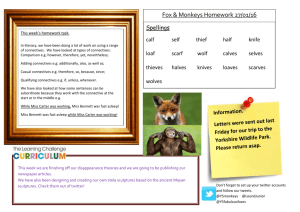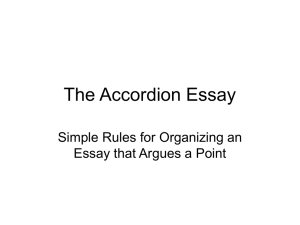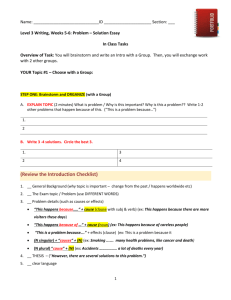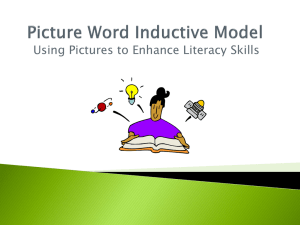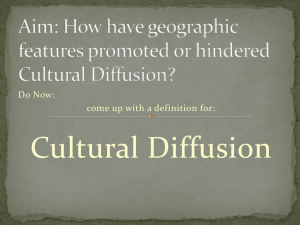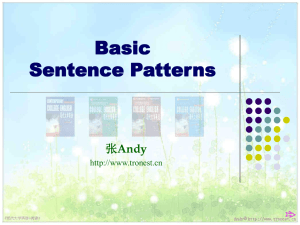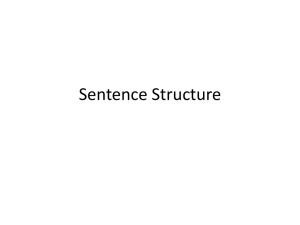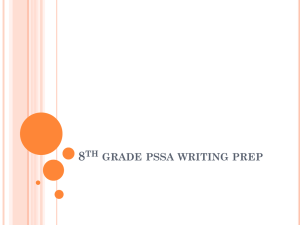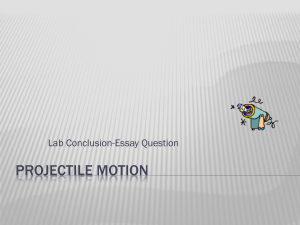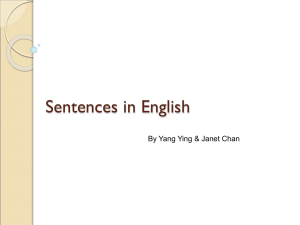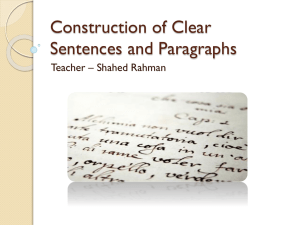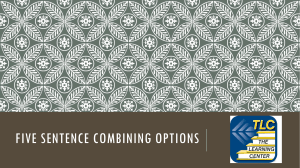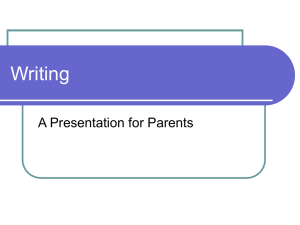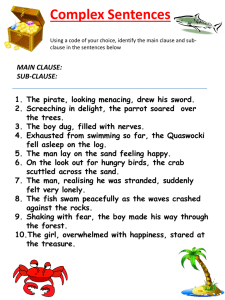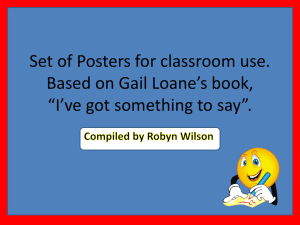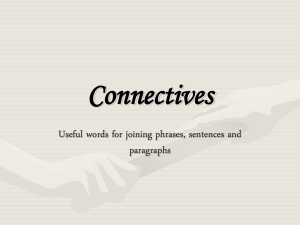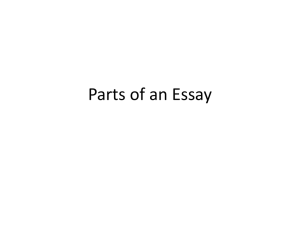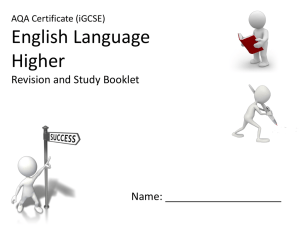Lit Mat Essay Structure to print
advertisement
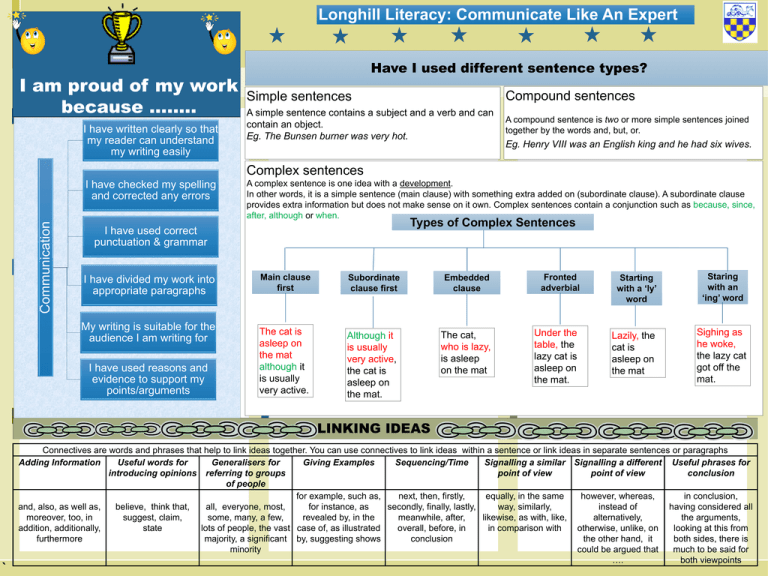
Longhill Literacy: Communicate Like An Expert I am proud of my work because …….. I have written clearly so that my reader can understand my writing easily Have I used different sentence types? Simple sentences Compound sentences A simple sentence contains a subject and a verb and can contain an object. Eg. The Bunsen burner was very hot. A compound sentence is two or more simple sentences joined together by the words and, but, or. Eg. Henry VIII was an English king and he had six wives. Complex sentences Communication I have checked my spelling and corrected any errors A complex sentence is one idea with a development. In other words, it is a simple sentence (main clause) with something extra added on (subordinate clause). A subordinate clause provides extra information but does not make sense on it own. Complex sentences contain a conjunction such as because, since, after, although or when. Types of Complex Sentences I have used correct punctuation & grammar I have divided my work into appropriate paragraphs My writing is suitable for the audience I am writing for I have used reasons and evidence to support my points/arguments Main clause first The cat is asleep on the mat although it is usually very active. Subordinate clause first Embedded clause Fronted adverbial Although it is usually very active, the cat is asleep on the mat. The cat, who is lazy, is asleep on the mat Under the table, the lazy cat is asleep on the mat. Starting with a ‘ly’ word Lazily, the cat is asleep on the mat Staring with an ‘ing’ word Sighing as he woke, the lazy cat got off the mat. LINKING IDEAS ` Connectives are words and phrases that help to link ideas together. You can use connectives to link ideas within a sentence or link ideas in separate sentences or paragraphs Adding Information Useful words for Generalisers for Giving Examples Sequencing/Time Signalling a similar Signalling a different Useful phrases for introducing opinions referring to groups point of view point of view conclusion of people for example, such as, next, then, firstly, equally, in the same however, whereas, in conclusion, and, also, as well as, believe, think that, all, everyone, most, for instance, as secondly, finally, lastly, way, similarly, instead of having considered all moreover, too, in suggest, claim, some, many, a few, revealed by, in the meanwhile, after, likewise, as with, like, alternatively, the arguments, addition, additionally, state lots of people, the vast case of, as illustrated overall, before, in in comparison with otherwise, unlike, on looking at this from furthermore majority, a significant by, suggesting shows conclusion the other hand, it both sides, there is minority could be argued that much to be said for …. both viewpoints Longhill Literacy: Communicate Like An Expert Common Command Words ESSAY ORGANISATION Describe Give a clear description that includes all the relevant features,, (including figure, names etc. where appropriate). Remember to write in paragraphs Use the 3 T’s to remind you to start a new paragraph T = Topic T = Time T = Talk Explain Set out in detail the meaning of something, with reasons. Examples are normally part of the explanation. When you are writing an essay – remember to: 1. Always start with an introduction which addresses the question. 2. Finish the essay with a conclusion which summarises the main points of your essay/argument and addresses the essay title again 3. Use connectives in each paragraph to link ideas and put them in a logical order. It is important to develop your paragraphs properly: • Start with a topic sentence which is the first sentence of a paragraph that tells the reader what the paragraph is about • Now add some developing sentences to develop your ideas and add details to the topic sentence. You should be aiming to include at least three developing sentences in each paragraph • Don’t forget to link your ideas (see above and over for examples of connectives) E POINT EVIDENCE • What point are you trying • If relevant, select a short to make? quote from the text that • What ideas are you supports your point. wanting to express? DON’T FORGET THE BASICS ` use ‘ ’ not ’ I use a full stop when I’m writing at the end of about myself. every sentence. E Summarise Write down briefly the main points or essential features. Compare Identify the main factors that apply in two or more situations and explain the similarities or advantages. Contrast Identify the main factors that apply in two or more situations and explain the differences or disadvantages. Evaluate Review the information then form a conclusion giving evidence for each view or statement. Using PEEL to structure your essay P Analyse Identify separate factors, say how they are related and how each one contributes. L EXPLAIN – LINK ANALYSE THE EVIDENCE • Link ideas within and - Analyse key words from across paragraphs (use your evidence appropriate connectives) - What is further revealed • Make sure you have about the meaning? linked your answer to the original question asked I use a capital I use a capital letter at the start letter for names of every and places. sentence. Justify Give reasons or evidence to support an opinion or point of view. To illustrate how a conclusion has been formed. Assess Make a judgment on the importance of something – similar to evaluate. I use for a place, when something belongs to someone & for ‘they are’. I use an apostrophe I don’t use an when shortening a apostrophe for word. words that are plural.


